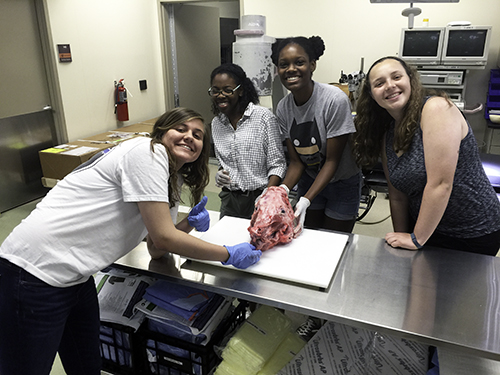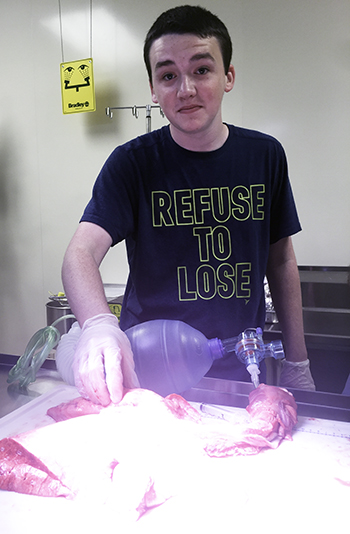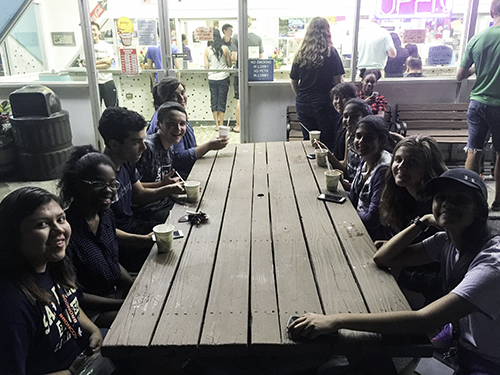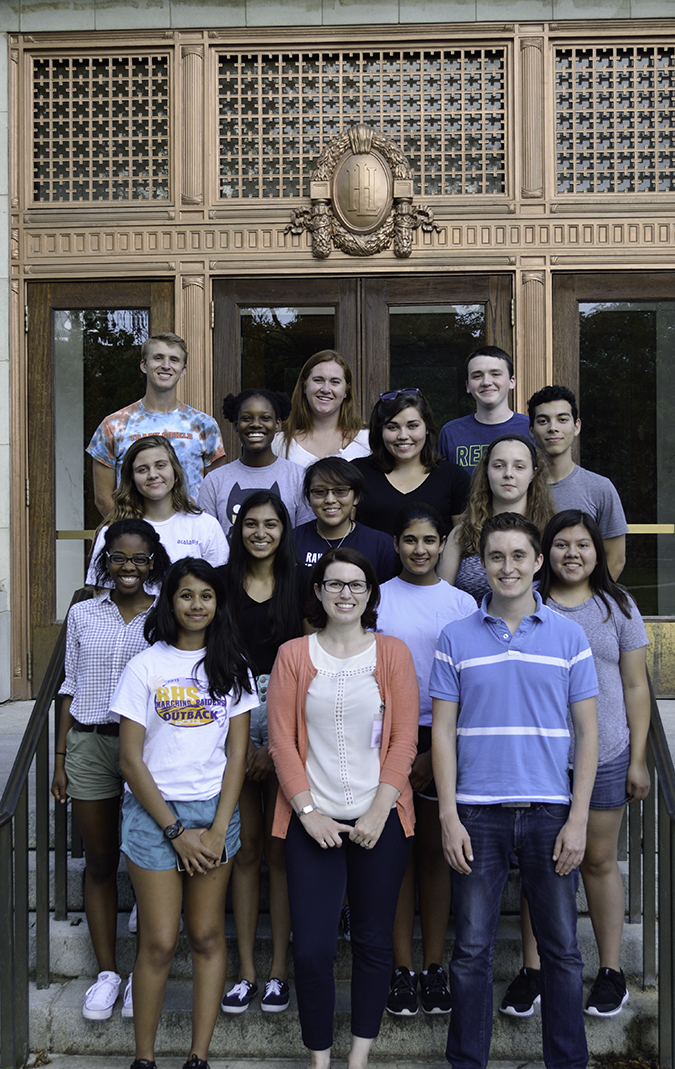Highschoolers Discover Global Health at CGS' First-Ever Global Health Camp
.jpg)
During a visit to Peoria's Order of St. Francis Medical Center, students have a chance to "listen" to the heartbeat of a training "patient."
July 5, 2016
The week of June 12–17th, twelve high school students, mostly young women, visited campus to participate in the Center for Global Studies’ (CGS) first-ever Global Health summer camp, which focused on some health-related global issues like nutrition/diet and the spread, treatment, and prevention of disease. The camp also addressed global health solutions and organizations, and for students seeking ways they could be involved, careers in global health.
When CGS approached Bioengineering Associate Professor Jenny Amos about doing a new Global Health Camp for summer 2016, her response was, “I’ve been doing camps for years, and I said, ‘Sure. What’s one more camp?’”
Amos, who has been running the Bioengineering GAMES camp for the last five years, adds, “I have experience running camps; I do curricula for a living; this is no problem. So it’s been a lot of fun.”
Helping with the camp was grad student Kenny Long, with whom Amos has been collaborating on an IGERT, plus developing a Global Health Certificate for undergraduate students, which includes a course, currently under development, where Illinois undergraduate students will collaborate with students from Sierra Leone to come up with solutions to solve some real-world global health problems.
The first cohort of twelve kids at the camp was mostly girls, which Amos says is pretty typical. “When you’re talking about education-related projects that have a high social focus, or health focus, you tend to get more women…Women are more engaged when they can see the social connection, or the impact.”
While the camp is focused is on health, Amos explains, “But we’ve taken a very broad definition to health.”

A Global Health camp participant administer's CPR to a dummy "patient" during their visit to the Order of St. Francis Medical Center in Peoria.
For instance, one activity related to nutrition about which Amos was very excited helped students understand how health can be impacted by economics. According to Amos, this activity is done by Bioengineering sophomores. On the very first evening, after their kick-off welcome activity, Amos and Long had students dive right into an exploratory study where they tried to come up with the most nutritious meal plan they could using items from a grocery store on $1 a day, $5 a day. “Its kind of just a fun, energetic way to start off. ‘Ok, you guys are settled; let’s go to the grocery store!’”
Following an introductory activity, during which they explained to students the concepts of how the human body gets energy from food, calories, and fat, they took the students on a field trip to County Market and turned them loose in the grocery store, where they did some research. Students were encouraged to find the most nutritious things they could. For example, they’d go find meat, and write down all the nutrition information, including the price of the meat. Then, the next morning, they had to put together meal plans for $1 a day, $5 a day, and then an unlimited amount of money for a maximum healthy diet (which Amos says usually involves foods like salmon, kale, and flax seeds).

Global Health Campers in a lab in Peoria's Order of St. Francis Medical Center.
“And for the dollar a day,” explains Amos, “you eat like Kraft mac and cheese, or an apple, and whatever, right? So they get to see that people aren’t choosing to eat badly; they’re victims of circumstance. People don’t want to go eat at McDonald’s every day, but sometimes that’s what they can afford, and it’s a lot of calories, and they need calories, but calories are not health. So it’s a really nice kickoff to nutrition, and what it means to be nutritious at low resource settings.”
For their main, week-long project, teams of three students researched a specific disease and the burden of that disease, such as its prevalence. Students were to look at different solutions in place right now, then come up with proposed solutions to this disease, or the healthcare system, or whatever they chose to focus on.
According to Amos, “Their project is pretty much all research.” Students picked a disease from the different lectures given by guest speakers throughout the week. Amos says students had “a lot of exposure to different diseases to choose from.”
To help students with their research, they learned about Illinois’ many resources, including its library system, and toured one of Illinois’ many libraries, while learning about library research and online searches from librarian Erin Kerby.

A Global Health camper experiences some biological material in a lab during the group's visit to Peoria's Order of St. Francis Medical Center.
Then, students had from Tuesday until Friday to work on their projects. Then, on Friday afternoon at the camp’s final event, students gave ten-minute oral presentations about the disease they had researched. Some of the things they were to discuss included the history of the disease, the prevalence within a specific country/area, how people are dealing with this disease today, and what they thought could be done in the future to prevent/mitigate the disease.
Many of the camp's participants, who were considering careers in health care most likely found Wednesday morning's field trip to Peoria, Illinois, particularly enlightening. They visited the Order of St. Francis Medical Center, an academic medical center that trains health care professionals of tomorrow. There students got some hands-on experiences that gave them a taste of what a career in health care might be like.
Another fun and educational activity which wasn’t directly related to health education, but to understanding the resource setting was a poverty simulation which involved role-playing. This activity was headed up by Business professor Madhu Vishwanathan and some of his staff from the Subsistence Marketplaces Initiative.
For the activity, via role play, students got to experience what it’s like to live in poverty situations. The simulation involved a number of different contexts, such as a social interaction where poverty is involved, a health-related situation, something in the market. Visiting the eight or so different stations, students got to experience what many of the world’s poor experience every day.
Another unique learning activity involved playing cards—not with hearts and spades, aces and kings—but with diseases. Students played Pandemic, a popular card game about the prevalence and spread of disease.
Amos says the activity was “Kind of keeping in the simulation spirit. So we have our nutrition simulation and poverty simulation, we’re going to teach them about epidemiology. We’ll have them play Pandemic and actually try to apply real principles, not just naïve game play, and see if they can beat the game by knowing more about epidemiology. So that should be really fun too. Really interactive.”

Campers enjoy some ice cream at Custard Cup.
According to Amos, through the game, students would learn about things like “mortality, morbidity…tracking malaria.”
While the week’s main emphasis was learning about global health, the campers also took time out from their work to learn about their college options during a dinner with a number of academic advisors from across campus. They got to play too; they went bowling and had a movie night, followed by a trip to a local favorite: Custard Cup.
The purpose of the camp was “to get students aware of global issues, especially pertaining to health,” says Amos. For students who are interested in that, they hoped “to have them understand their options, career wise. So we have people coming in to talk about NGO’s they can get involved in, or degrees that they can pursue.”
Amos goes on to explain that Global Health is a complex issue; there’s not just one unit or degree for global health. But however they want to get involved, she wants them to know that they can learn about it at Illinois.
“Any of us can work in global health and input on that,” she continues. “So we want them to understand that it’s a complex issue and that there are many paths, that there are many ways you can work in global health, from an academic research perspective, from an NGO perspective, from many different perspectives. And we want them to understand that they can do it here in Illinois, and hopefully we can recruit some of them here.”
Story by Elizabeth Innes, Communications Specialist, I-STEM Education Initiative.
Photos courtesy of the Center for Global Studies.
More: 8-12 Outreach, Center for Global Studies, Summer Camp, 2016
For additional I-STEM articles about Center for Global Studies camps, see:
- Sustainable Futures Campers Experience Sustainability In and Out of the Classroom
- Sustainable Futures Workshop StokesHigh Schoolers' Passion: Sustainability

The participants of the 2016 Global Health camp, including camp coordinator Jenny Amos (center, front row) and her grad student assistant Kenny Long (right, front row).













.jpg)
















